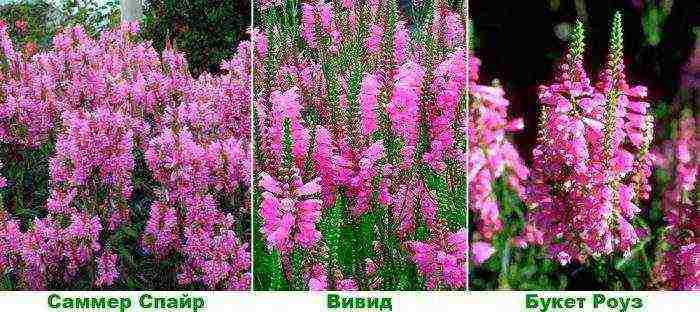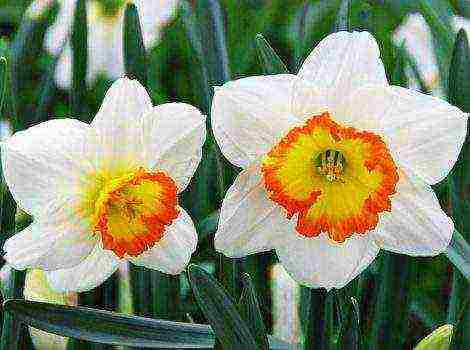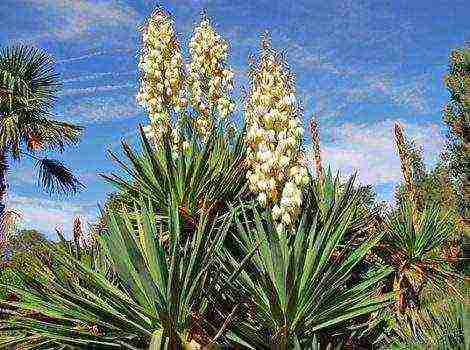Content
- 1 Growing physostegy from seeds
- 2 Planting physostegia in open ground
- 3 Reproduction by dividing the bush and layering
- 4 Reproduction of physostegia by cuttings
- 5 How to maintain physical fitness in the garden
- 6 Physostegy varieties with photos and names
- 7 Physostegy in landscape design
- 8 Popular varieties of the only species in the culture
- 9 Photo gallery of views
- 10 Growing and caring
- 11 Reproduction
- 12 Use in landscape design
- 13 Features of physostegia
- 14 Growing physostegy from seeds
- 15 Planting physostegia in open ground
- 16 Physiostegy care in the garden
- 17 Physostegia after flowering
- 18 Types and varieties of physostegy with photos and names
Physostegia (Physostegia) is a perennial herb of the Lamb family. Originally from North America. The name is formed by two Greek words meaning "cover" and "bubble". This is due to the bloated shape of the flower calyx. Physostegy is also called a false snakehead.
Culturally grown only virgin physicalostegia. It is a herbaceous plant 60-120 cm high. The stem is powerful, erect, tetrahedral. The root system is creeping, actively growing. Leaves are oblong, lanceolate, have serrated edges, are arranged in pairs, sessile. Two-lipped tubular flowers are bisexual, less often unisexual. Painted in white, lilac, purple. The spike-shaped inflorescence reaches a length of 30 cm. Flowering starts in mid-summer and lasts until the end of September. Fragrant flowers attract bees. The fruit is a small nut.
Growing physostegy from seeds
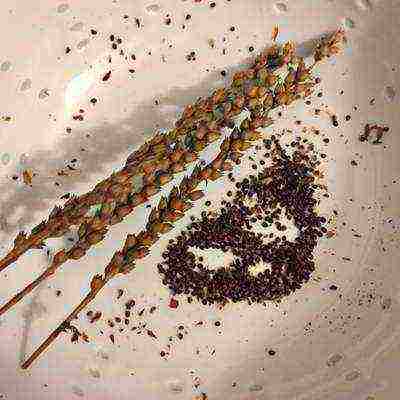
Physostegy seeds photo
The seeds have a high germination rate.
Sowing in open ground is done before winter or early spring. It reproduces well by self-seeding.
Growing seedlings
To get stronger and more viable plants, seedlings should be grown.
- Planting physostegy seeds at home in March.
- Fill the boxes with loose nutritious soil, sow seeds (do not cover deeply - up to 0.5-1 cm), moisten, cover with foil or glass.
- Well, if sowing is carried out in cassette cups for 2-3 seeds, then the seedlings will be strong and you will not need to thin out the plants.
- Germinate in a warm, light place. Expect to germinate about 2 weeks.
- Ventilate the greenhouse daily, keep the soil moist. With the emergence of seedlings, the shelter can be removed.

Physostegia growing from seeds photo shoots
Protect young plants from direct sunlight and drafts. Water, loosen the soil gently so the roots can breathe. With the appearance of two true leaves, thin out the seedlings, leaving a distance of 7-10 cm between them. It can be planted in open ground in late May-early June. A couple of weeks before that, harden the seedlings - leave boxes with seedlings in the garden for several hours a day.
Planting physostegia in open ground
Physostegia grows well both in an open sunny area and in partial shade.
The soil is needed loose, nutritious, capable of retaining moisture: black soil, loam or sandy loam soils.
- When planting, keep a distance of 25-30 cm between plants.
- Physostegia rhizome grows rapidly and can drown out other crops planted on the site. Restrictions will be needed.A metal, plastic, slate or wooden fence should be dug around the perimeter of the flower bed to a depth of 30-40 cm.
- You can plant the plants in a wide-diameter pipe section or in an old bucket without a bottom.
- The limiter should be covered from above with a layer of soil no more than 2-5 cm thick.
Reproduction by dividing the bush and layering
The division of the bush is carried out before flowering in the spring or after it ends in the fall. This can be done during flowering - the plant will successfully take root, but you will lose the inflorescences. Dig out the bush, the ground part must be cut off, the rhizome divided into parts and planted.
Reproduction by lateral shoots (they grow on creeping rhizomes at some distance from the mother bush) is carried out in late summer or early autumn. Dig, plant in partial shade, transplant to a permanent place of growth in the spring.
Reproduction of physostegia by cuttings
Root the cuttings in early summer. Before the start of flowering, cut the cuttings 10-12 cm long, they should contain a couple of buds. Root in a container of damp sand in the shade of your garden. For the winter, transfer to a cool room, in the spring, plant it on a training bed, and after another year - on a permanent place of growth.
How to maintain physical fitness in the garden

How to plant physicalostegia in the ground photo
Watering and loosening the soil
- Water regularly in dry weather.
- In rainy weather, it is content with precipitation.
- To retain moisture, cover the area.
- Loosen the soil after watering or rain. Remove weeds.
Top dressing and transplanting
Before flowering, apply complex mineral fertilizers with watering.
A transplant is recommended every 5 years. Do this after flowering. In order for the plants to take root well, it is necessary to ensure regular watering.
Diseases and pests
From an excess of moisture, a fungal infection can strike physostegia - remove the affected areas, treat with a fungicide.
Aphids may appear from pests. Treat the plant with insecticide.
How to collect seeds
From late August and throughout September, seeds can be harvested. They are large, hiding at the bottom of the bracts in the cups, but with strong gusts of wind they can spill out. Therefore, it is better to remove them and dry them in a dry place with good ventilation.
Wintering
The plant is resistant to cold weather, but in the northern regions it is better to cover for the winter. Cut the stems (leave 2-5 cm above the soil surface), sprinkle with sawdust, peat, dry foliage or cover with spruce branches.
Physostegy varieties with photos and names
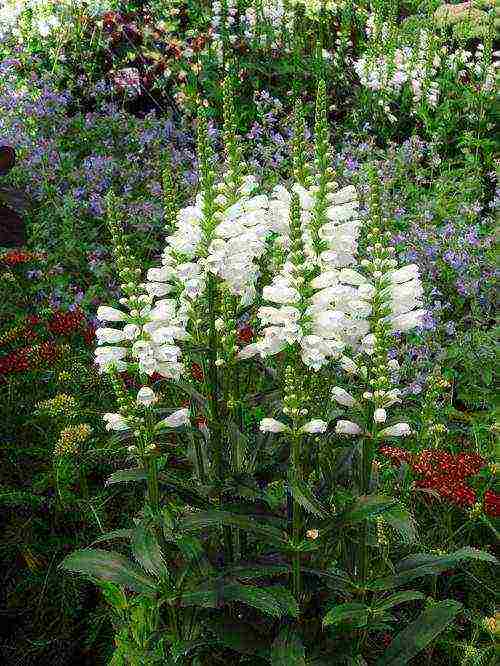
Physostegia crystal peak crystal peak white in garden design photo
Physostegia virginiana, grown decoratively, has several varieties.
Alba is a plant about 80 cm high. Large white flowers gather in a dense apical inflorescence.
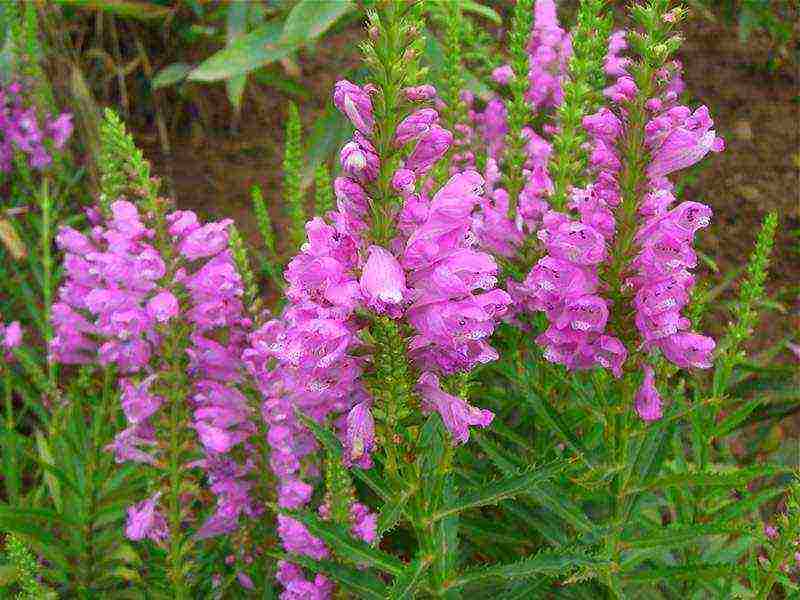
Physostegia pink queen growing from seeds photo of flowers
Variegata - grows up to 90 cm. Green leaves are bordered by a white stripe. The flowers are bright pink.
Summer Snow - physostegy 90 cm high. The leaves are green, the flowers are snow-white.
Summer Spire - extends 90 cm. The stem is covered with green leaves. The dense spike-shaped inflorescence consists of dark pink flowers.
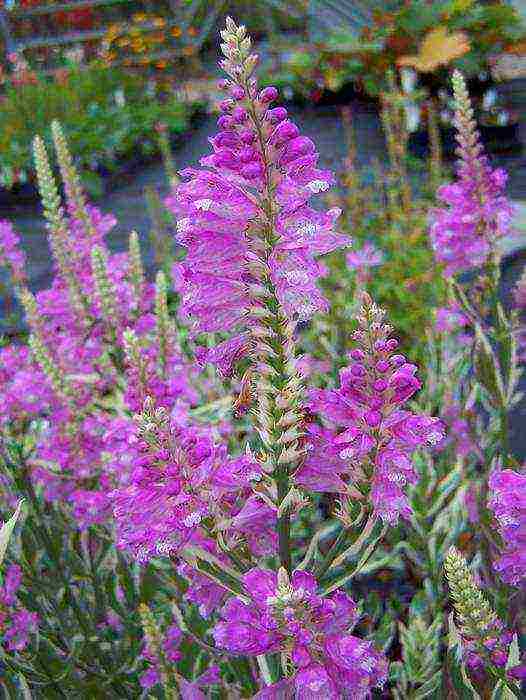
Physostegia virginiana variegata Physostegia virginiana Variegata photo
Vivid - reaches a height of 60 cm. Flowers have a pale pink color.
Rose bouquet - plant height is 1.2 m. The color of flowers is bright lilac.
Pink Queen - reaches a height of 70 cm. The flowers are pink.
Physostegy in landscape design

Physostegy in landscape design photo
Looks most impressive in group plantings. Good for framing paths. Plant along fences, garden buildings, in mixborders, near water bodies. Good neighbors will be dahlias, echinacea, veronica, phlox, thuja, catnip, juniper, dwarf pines.

Physostegia and roses photo flower beds
White physostegia looks luxurious in joint plantings with scarlet roses.

Physostegia variegated in garden design photo flower beds
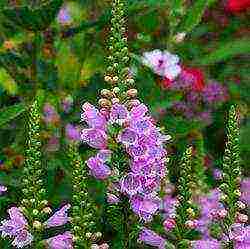 This tall perennial of the Lipocystae family is a relative of sage and complements the design of parks and summer cottages. Physostegy: correct planting, growing conditions, timely care, reproduction and photos of plant varieties.
This tall perennial of the Lipocystae family is a relative of sage and complements the design of parks and summer cottages. Physostegy: correct planting, growing conditions, timely care, reproduction and photos of plant varieties.
Description of physostegia: varieties and varieties
Currently, 12 types of physostegia are known. Herbaceous perennial plants with flowers of different shades reach a height of more than 2 meters, they winter well in the open field, they easily propagate by seeds and dividing the bush.
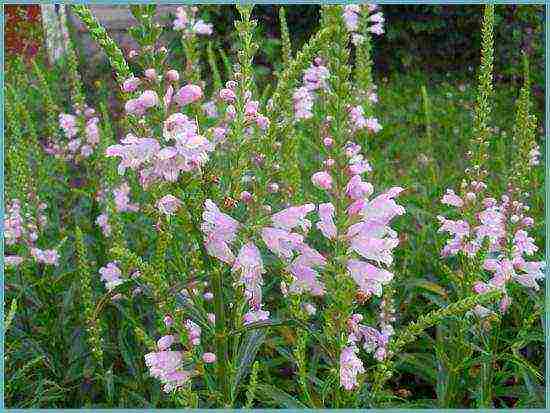
Physostegia virginian
Florists usually grow in the open field one variety of physicalostegia - P. virginiana... The rhizome of the plant grows rapidly and strongly, giving life to many bushy shoots covered with opposite leaves.
The cultivation of this culture does not cause much trouble: perennial plants develop well, the beginning of the flowering of the variety coincides with the middle of July. Physostegia flowers are collected in a spike-shaped inflorescence, two-lipped, characteristic of representatives of the family Labiata. The color of flowers is delicate: pink, white, lilac tones. The subtle scent of physostegy attracts many bees to the plant. Physostegia virginskaya variety is an excellent honey plant, the duration of flowering is until September.
In landscape design, they actively use varieties of physostegia virginskaya:
- "Summer snow" - white flowers, the height of the peduncles reaches up to 1 m.

Variety "Summer Snow"
- "Variegata" - delicate pink flowers of this variety harmoniously complement the white-bordered leaves. The height of the variety is up to 90 cm.
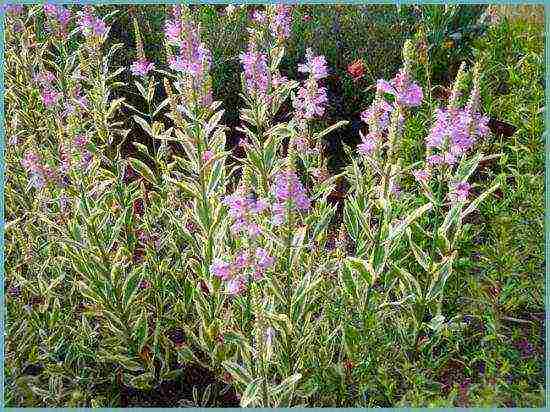
Variety "Variegata"
- "Pink Queen" - up to 70 cm high, has a spike-shaped inflorescence with pink flowers.

Variety "Pink Queen"
Planting physostegia
For the dynamic development of a plant, the planting of physostegia is carried out in a soil rich in humus, but at the same time, loose, light, capable of retaining moisture. Planting physostegy perfectly put up with partial shade, bloom well in lighted, sunny areas.
Attention! A fast-growing rhizome is capable of displacing other plants from the planting site, therefore, the development of the root system of physostegy should be limited.
To do this, planting plants is carried out in dug-in containers, or special restrictive screens are laid in the ground, which prevent the growth of rhizomes.
Plant care
Considering that physostegia is a perennial plant that can develop in one place without transplanting for many years, crop care comes down to regular watering, loosening the topsoil and mulching the soil surface in beds with physostegia.
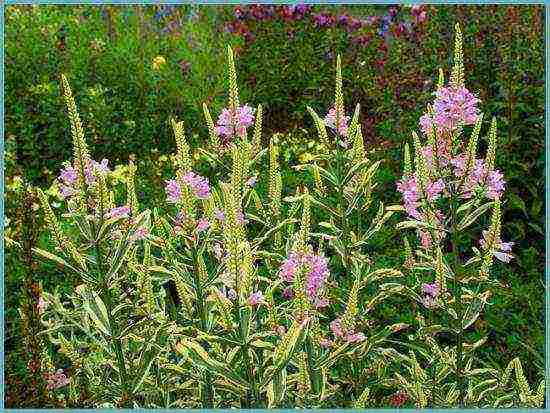
The main concern of the gardener is to carefully prepare the plant for wintering.
The perennial should be carefully prepared for wintering: cut off dried stems and flower stalks, mulch the rhizomes with compost. On top of the mulch layer, spruce branches must be laid: in winters with little snow, the rhizome freezes easily.
In winter, the rhizomes of physostegia also require care: it is necessary to monitor the proper insulation of dormant rhizomes, to insulate them with snow along the sketched spruce branches.
Advice. In order to avoid damping out of the rhizomes of physostegia in the spring, it is best to remove excessive insulation with the onset of the first sunny days.
Fertilizing and feeding physostegy
The culture does not require the introduction of any special fertilizers. The excess of nutrients causes the plants to grow wildly. This requires additional pruning of bushes and operations to limit the growth of rhizomes. A single application in the spring of complex fertilizer under the bushes of physostegy and a single fertilization with microelements during the growing season of the plant is allowed.
Plant propagation
Rapidly growing physicalostegia easily reproduces vegetatively. Reproduction of this plant by dividing the rhizome is the most frequent way to obtain planting material for physical osteology. The plant strips take root quickly and well when planted in light, moist soil, and it does not matter when the division is carried out, in spring or autumn.

It is most convenient to propagate the plant by dividing the rhizome
Also widely practiced reproduction of varieties of physostegy by layering... The green growth with part of the rhizome is separated from the mother plant and planted in a permanent place. Layers start growing very quickly. With such reproduction, it is important to maintain high humidity in the soil, but at the same time to prevent overflow. Watering plants of physostegia is carried out periodically, sufficiently saturating the ground in the garden.
Seed reproduction most expedient when breeding new varieties. However, the plant produces good self-seeding, scattering seeds over considerable distances.
Diseases and pests
Physostegia is a perennial very resistant to diseases and pests. Occasionally, plantings are harmed by aphids, which can be eliminated with the help of systemic drugs.

Physostegia and lyatris on the same flower bed
Physostegia: Combination with other plants
A lush, ornamental physostegy bush looks great in single plantings on flower beds and ridges, as a tapeworm for decorating lawn areas.
Interesting combinations of physostegy with decorative conifers:
- firs;
- cypress trees;
- thujami;
- junipers.
Physostegy will add sophistication to a perennial mixboder. In combination with Veronica, Bugwort, Meadowsweet, Liatrice, Physostegy fits perfectly into the design of flowering flower beds, landscape design of park zones and city squares.
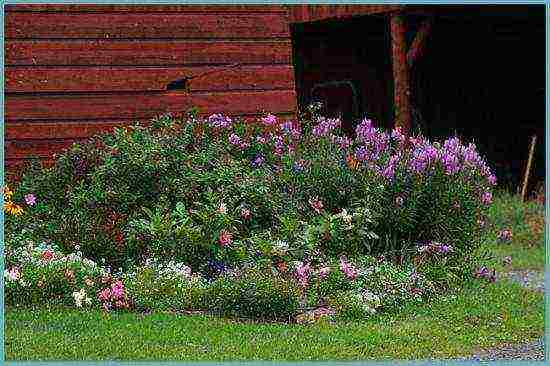
Physostegy in landscape design
Lush vegetation of physostegy is appropriate in the design of ponds and fountains.
Physostegy in landscape design
The value of the culture of physicalostegy lies in long, long flowering, rapid growth and easy reproduction. The plant is actively used in landscape design to decorate green areas and flower beds. A wide palette of delicate colors of flowers helps to find the perfect combination with partner plants.
Physostegy at their summer cottage: video
Types of physicalostegia: photo
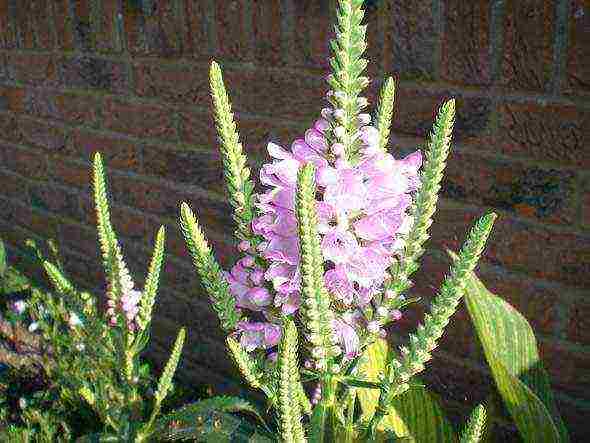
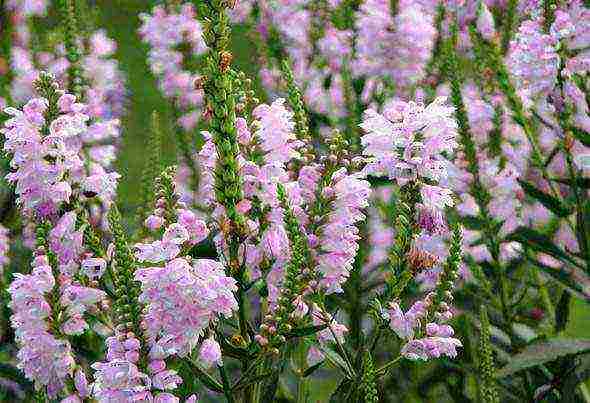


Physostegia (lat. Physostegia) is a genus of perennial herbaceous plants of the Labiaceae family. Under natural conditions, it grows only in North America, with the exception of the state of Florida. The name comes from the Greek words "physa" - bubble and "stege" - cover, indicating that there are swollen cups around the ripe fruit. For the original shape of the flowers, the plant is sometimes called a false snakehead.
Description
Physostegia rhizome is creeping, aggressively growing. Stems up to 1.2 m tall, erect, tetrahedral, branched. Leaves are lanceolate or oblong, opposite or paired, sessile, serrated along the edge. The flowers are two-lipped, tubular, bisexual (less often unisexual), collected in a spike-shaped inflorescence up to 30 cm in length. The color of the flowers of physostegia: white, pink, purple, lilac. The fruit is a nut.

Physostegia
The plant is frost-resistant. The flowering period is long, approximately 40-45 days, starting in mid-July. The seeds ripen in August-September.
Popular varieties of the only species in the culture
The genus is not numerous, according to various sources it includes 3-12 species. In culture, only one is grown.
Physostegia virginian (Latin Physostegia virginiana). It is characterized by straight stems, slightly branched in the upper part, up to 90 cm high. Leaves are linear-lanceolate, opposite, light green. White, pink, lilac, purple, lilac flowers are collected in a dense spike-shaped inflorescence. Frost resistance is high. Bears fruit abundantly, easily reproduces by self-sowing.
The garden form of Virginia Physostegia - Physostegia "Alba" has been bred. Bush up to 80 cm high with large white flowers in a dense apical inflorescence. The flowers are large, white.

Physostegia virginskaya, grade "Summer Snow"
Noteworthy varieties:
- "Vivid" - up to 60 cm in height, flowers of a pale pink color;
- "Summer Snow" - tall (up to 90 cm) plant with snow-white flowers;
- "Bouquet Rose" - reaches 120 cm in height with bright lilac flowers.
There are variegated (variegated) form with stems especially resistant to lodging from the wind. The bush does not exceed 90 cm in height. The leaves are green with a white edging, the flowers are bright pink.
Photo gallery of views
Growing and care
Location... It grows equally well both in open sunny areas and in light shade.
The soil... Loose rich soil, not too light, moist. On scanty dry soils, physostegia may die.
Landing... Before planting physostegia, it is recommended to add peat, compost and mineral fertilizers to the hole. The bushes are planted at a distance of 45-50 cm. The plant's growth pattern is aggressive. The roots grow very quickly, oppressing those growing near neighbors. When planting, you need to take into account this feature of physostegy. Ways to solve the problem:
- along the perimeter of the landing pit to a depth of 30-40 cm, dig in a metal, wooden, plastic fence; pieces of slate are also suitable for this purpose;
- regularly dig up excess growth along with the roots.

Ripening Physostegy Seeds
Watering... The plant is demanding on soil moisture. Regular abundant watering is required. Some time after watering, the soil around the bushes should be loosened to provide air access to the root system.
Top dressing... The plant is very responsive to fertilization. For abundant flowering, it is necessary to make complex water-soluble dressings every two weeks, combining them with watering.
Pruning... In the fall, shoots are cut just above ground level. Pruning too short can freeze the plant.
Transfer... After planting, the plant reaches full decorative effect for 2-3 years. Further, for a few more years (up to five), physostegy can grow in one place. In the future, to preserve decorativeness, the bushes need to be divided and planted.
Diseases and pests... Under unfavorable conditions, it is affected by fungal diseases. At the first signs of the disease, as well as for prevention, the plant must be treated with fungicides.
Shelter for the winter... In regions with harsh winters, shelter with coniferous spruce branches or other materials is desirable. In regions with warm climates, the plant hibernates without shelter.

Physostegia virginskaya in the area
Reproduction
Physostegia reproduces: by dividing the bush, layering, cuttings, seeds.
In early spring or autumn after flowering, physostegia bushes are dug up and cut into pieces, leaving several shoots on each of them. Delenki are planted as an independent plant at a distance of 45-50 cm.
Layers grow on their own at a distance from the mother bush. At the same time, young shoots do not oppress nearby plants. Layers are dug up and grown on a shaded temporary bed for a year. Next, the seedlings are planted in a permanent place. Flowering occurs in the 2-3rd year.
Dividing the bush and reproduction by layering are considered the simplest and most reliable ways.
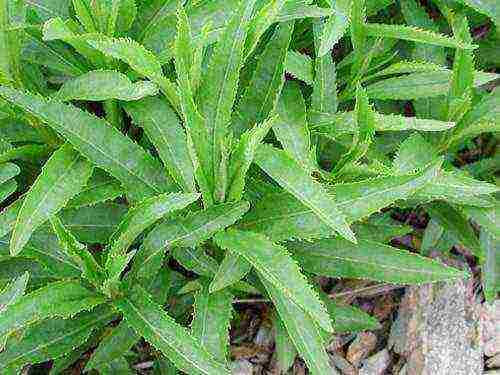
Physostegia at the beginning of the growing season
To preserve the variety of rare specimens, reproduction of physostegy by cuttings is possible. Cuttings are cut in summer before flowering. Their size is 10-12 cm with several pairs of buds. Cuttings are rooted in containers with wet sand in a shady place. In winter, the containers are removed to a cool place and make sure that the plants are not affected by fungal diseases. The following spring, rooted cuttings are planted first in a temporary bed, and a year later - in a permanent place.
Seeds sown directly into the ground in early spring or before winter give amicable shoots. For seedlings when growing physostegia by seeds, they are sown in March.
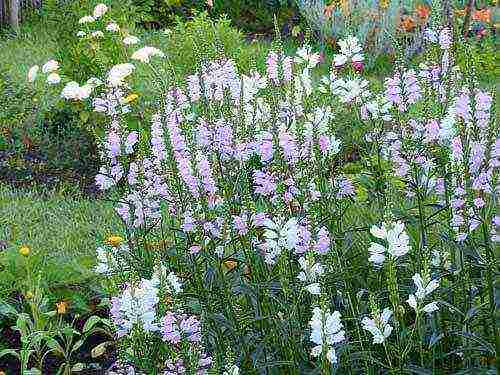
Physostegy in the garden
Use in landscape design
The decorative leaves of the physostegia and the long flowering have made it a favorite of landscape designers and hobby gardeners.It is grown along the perimeter of fences, in prefabricated mixborders, for landscaping the area near decorative ponds and fountains, as a tapeworm in the design of lawns.
Partners in prefabricated flower beds can be: phlox, dahlias, yaskolka, tradescantia, echinacea, chamomile. Excellent results are achieved by combining physostegy with conifers: dwarf spruces, thujas, junipers.
Physostegy flower stalks are successfully used to decorate bouquets. In pots with water, all flowers bloom and retain their decorative effect for a long time.
A herbaceous perennial plant physostegia (Physostegia) is a representative of the family Labiatae or Clarice. According to information taken from various sources, this genus unites 3–12 species. Such plants can be found in the wild in North America. The name physostegia comes from 2 Greek words that translate as "bubble" and "cover", which is associated with the calyx of the flower, which has a swollen shape. Because of this feature of the plant, it is also called "false snakehead". Only one species is cultivated by gardeners - Virginia physicalostegia.
Features of physostegia
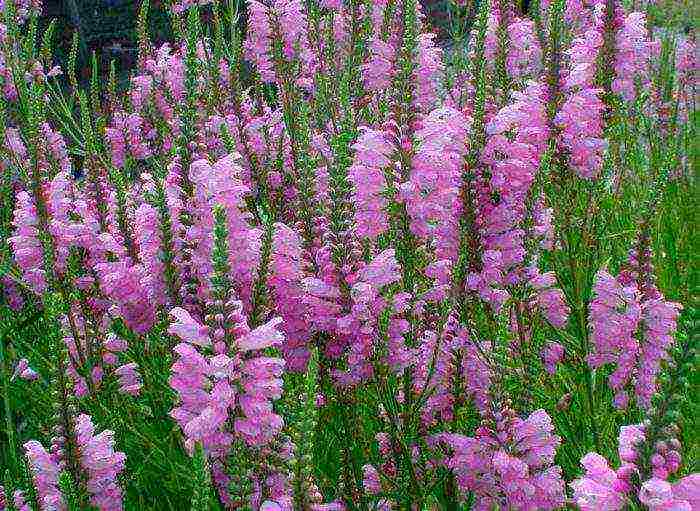
Such a not very noticeable perennial plant as physostegia is capable of forming rather dense clumps. The height of the tetrahedral strong erect stems can vary from 0.6 to 1.2 m. The growing creeping rhizome of such a flower is aggressive. Sedentary, opposite or paired leaf plates of lanceolate or oblong shape have a serrated edge. The length of the spike-shaped inflorescences is about 0.3 m, they consist of two-lipped tubular flowers, which, as a rule, are bisexual, but also unisexual. The color of the flowers is white, purple, pink or lilac. The smell emanating from them helps to attract bees to the garden. The plant blooms in the middle of the summer period, and only fades in September. The fruit is a small nut.
As a rule, physostegia in the garden is planted in not very large groups near the paths. Often, this plant is grown along the perimeter of the garden along the fences, it is framed by ponds or fountains, and is also grown in mixborders. Such a flower is recommended to be planted together with echinacea, thuja, juniper, phlox, dahlias and dwarf spruce. Everyone can plant and grow physostegy.
Growing physostegy from seeds
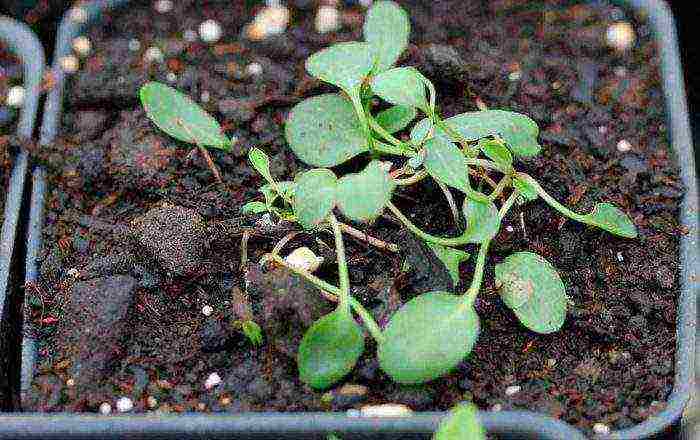
Sowing
Physostegia seeds are highly germinating. As a rule, they are sown in open soil immediately after harvest. Such a flower is able to reproduce independently by self-seeding. With a strong desire, it is quite possible to grow physicalostegia through seedlings, especially if you want to get a new variety. Sowing seeds for seedlings is carried out in March. Crops should be transferred to the greenhouse.
Growing seedlings
The first seedlings can be seen 14 days after sowing. You need to care for the seedlings of such a flower in the same way as for the seedlings of almost any other garden plant. Watering is carried out only after the top layer of the substrate dries out. In the event that a crust appears on the surface of the soil mixture, it will need to be carefully loosened. Seedlings must be protected from drafts and direct sunlight.
Picking

When the seedlings have a second true leaf plate, they will need to be picked. The distance between the unpicked plants should be from 7 to 10 centimeters. Half a month before the scheduled day of planting plants in open soil, you should start hardening them. To do this, the seedlings must be transferred to the street every day, gradually increasing the duration of their stay in the fresh air until they fully adapt to the new conditions.
Planting physostegia in open ground
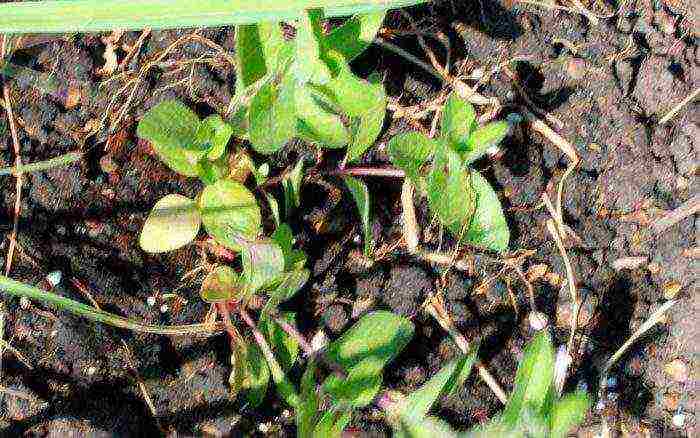
What time to plant
Physostegy seedlings are transplanted into open soil in the last days of May or the first in June. Such a flower is rather unpretentious to growing conditions.In this regard, for planting it, you can choose both a well-lit and a shaded area. The soil should be moist, loose and saturated with humus. It is also important that it can retain water well. Loamy, sandy loam soil or black soil is ideal.
How to plant correctly
A distance of 25-30 centimeters should be kept between the plants. Physostegia has a rapidly growing rhizome, which is capable of displacing other flowers from the site. To avoid this, a restrictive system must be made when landing. So, plants can be planted in open soil in a container, which will limit the growth of their rhizomes, for example, you can use a piece of an old pipe or a bucket without a bottom. In this case, the container must be dug in so that from its upper edge to the surface of the site there is a layer of soil 20–50 mm thick. Also, very often, a fence made of metal, slate, plastic or wood is dug in along the perimeter of the flower bed, while the sheets need to be buried into the soil by 0.3–0.4 m.
Physiostegy care in the garden
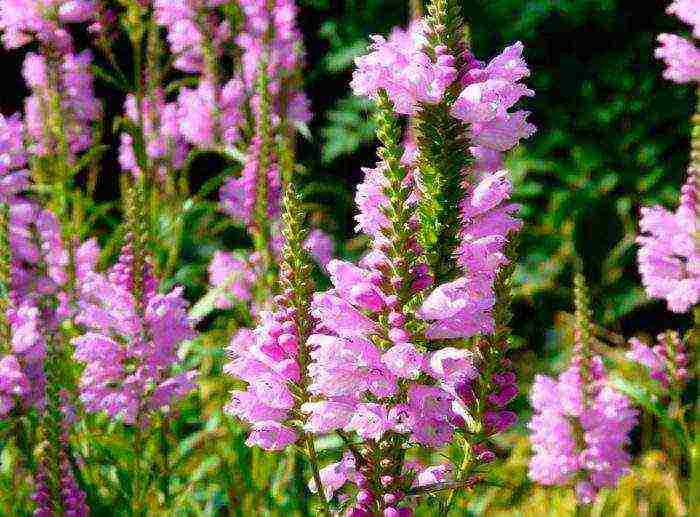
In order for the physostegia to grow and develop normally, it must be systematically watered, after this procedure, the soil is compulsorily loosened together with the removal of weeds. The site must be covered with a layer of mulch, provide the plant with timely feeding, as well as protection from pests and diseases and preparation for wintering.
This flower is quite hygrophilous. In this regard, during the dry period, it must be watered in a timely manner. In the event that it rains systematically in the summer, then physical therapy can do without watering. It is necessary to remove weeds and loosen the soil surface after each rain or watering. In order to facilitate the care of physostegia, it is recommended to cover the surface of the area with a layer of mulch (humus or peat), in this case the number of weeding, loosening and watering will be significantly reduced.
If the soil is saturated with nutrients, then the subcortex of physostegy is arranged only 1 time per season and a water-soluble complex mineral fertilizer is used for this. Top dressing must be done together with watering. It is recommended to feed such a plant before flowering.
Reproduction of physostegia
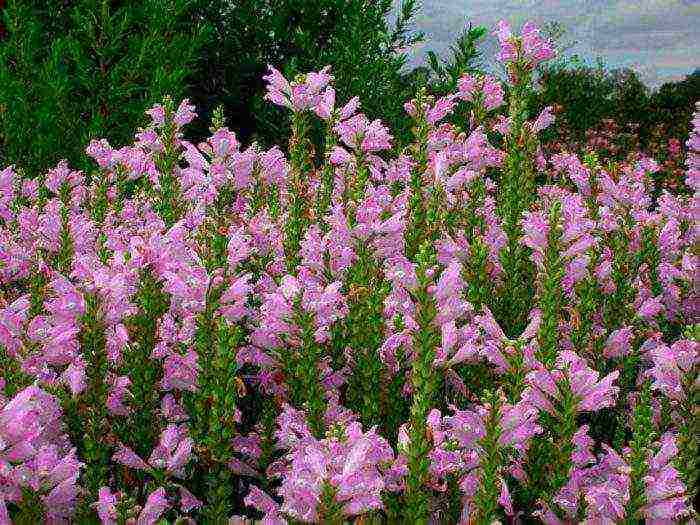
This flower can be propagated not only by seeds, but also by a vegetative method, namely by dividing the rhizome or bush, layering, and also by cuttings. It is recommended to divide the bush in the spring (before the plant blooms) or at the end of the summer period (at the end of flowering). However, some gardeners divided the bush directly during flowering and the divisions took root very well, but in this case it is imperative to cut off all the inflorescences from the plant. Remove the bush from the soil and cut off the aerial part from it. Then it is divided into several parts. Plants should be planted in the same way as seedlings.
In the first summer weeks, you can try to propagate physostegia by cuttings. Cuttings are harvested before the plant blooms, while their length should be from 10 to 12 centimeters. Each cutting should have several pairs of buds. For rooting, they are planted in moistened sand, which is filled in a box or container. The container must be removed to a shaded place. The cuttings will hibernate in a cool room, and with the onset of the spring period they will need to be transplanted to a training bed. It will be possible to plant the cuttings in a permanent place only after another 1 year.
At a sufficient distance from the parent plant, layers with rosettes grow, while the oppression of flowers growing in the neighborhood does not occur. They should be dug up and transplanted into a shaded area. Before the layers are transplanted to a permanent place, they must be grown for 1 year.
In the autumn, the division of the rhizome is carried out. The separated white scraps are planted in a permanent place. They root very well, but it takes a little longer than rooting the cuttings.Remember that when fizostegia is multiplied by dividing a bush, rhizomes or layering, the soil near the plants should be constantly slightly damp, but not damp.
Transfer

In the second or third year of life, physostegy takes on the most spectacular appearance. Without a transplant, it can be grown for no longer than 5 years. Then the bushes are removed from the soil, divided and planted in new places. Physostegia should be transplanted and looked after during this period in the same way as during the initial planting. The transplanted plant needs abundant watering, and experienced gardeners also recommend immediately covering the surface of the site with a layer of mulch.
Diseases and pests
Such a plant has a very high resistance to diseases and pests. However, sometimes aphids can settle on the bush. To destroy such a harmful insect, the bushes should be sprayed with Biotlin, Antitlin, Aktellik or another insecticide designed to combat such pests.
If water stagnates systematically in the soil, then the plant may develop a fungal disease. In this case, it should be sprayed with a fungicide as soon as possible.
Physostegia after flowering
Seed collection
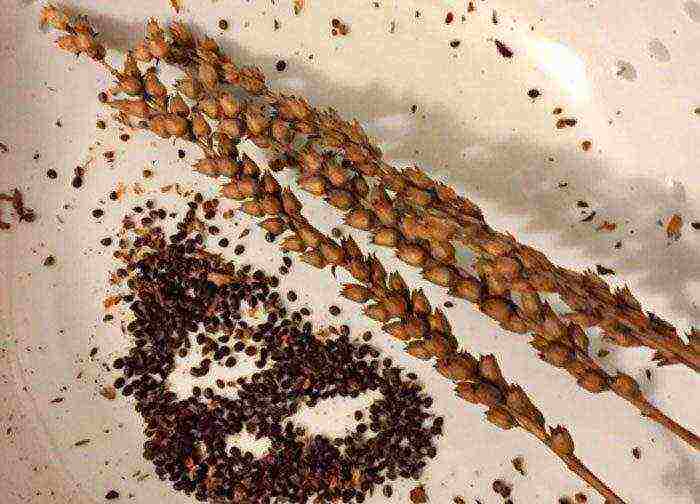
In the cups at the bottom of the bracts are large ribbed black seeds. In strong winds, they can fall on the site. Seed collection is carried out from the last days of August to early October. Then the seeds must be completely dried, for this they must be laid out in a well-ventilated room with low air humidity. Dry seeds can be stored.
How to prepare for wintering
In regions and countries with a mild climate and warm winters, for example, Moldova, Ukraine, the southern part of Russia, physostegy can be left uncovered for the winter, since it has a relatively high frost resistance. However, if this plant is cultivated in a region with frosty winters, then it must be prepared for the winter period. First you need to cut the shoots of the bush to a height of 20 to 50 millimeters above the ground. After that, the site should be covered with a thick layer of sawdust, peat, dried foliage, if desired, the bushes can also be covered with spruce branches.
Types and varieties of physicalostegia with photos and names
As already mentioned at the beginning of the article, gardeners cultivate only 1 type of such a plant - Virginia Physostegy, as well as its various varieties and hybrids. You can find a detailed description of this type above. The most popular varieties and hybrids among gardeners:
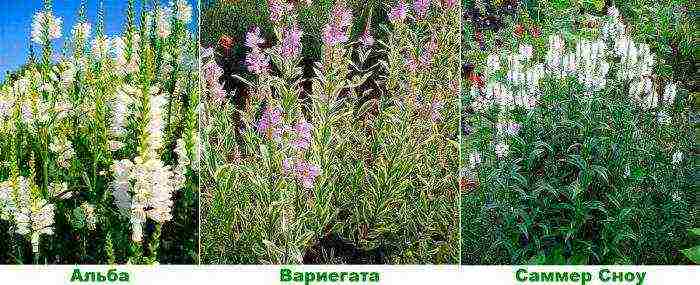
- Alba... The bushes reach a height of 0.8 meters. The apical dense inflorescences consist of large white flowers.
- Variegata... This is a variegated form. In height, the bushes can reach about 0.9 meters, they have shoots that are especially resistant to lodging. A white border runs along the edge of the green leaf plates. The color of the flowers is deep pink.
- Summer Snow... Plant height is about 0.9 m. The color of the leaf plates is green. Snow-white flowers are part of spike-shaped inflorescences.
- Summer Spire... The bushes reach a height of about 0.9 m.The color of the flowers is deep pink, and the foliage is green.
- Vivid... The height of the bush does not exceed 0.6 m. The color of the flowers is light pink, and the foliage is green.
- Rose Bouquet... The height of the plant can reach up to 1.2 m. The flowers are painted in a rich lilac color, and the foliage is green.
- The Pink Queen... The height of the bush is about 0.7 m. Pink flowers are part of the spike-shaped inflorescences.
